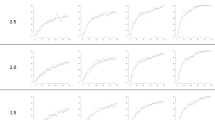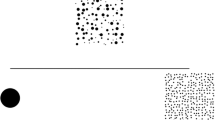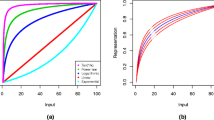Abstract
AN educated adult can tell which of two digits is the larger with virtually no uncertainty. By what process is this accomplished ? On the one hand, it is conceivable that such judgements are made in the same way as judgements of stimuli varying along physical continua. On the other hand, numerical judgements may be made at a different, less perceptual and more cognitive, level. For instance, the task may be one of memory access, each possible pair of numerals being stored with a corresponding inequality sign ; or perhaps some sort of digital computation is performed, such as counting the space between the two numerical values.
Similar content being viewed by others
References
Hemmon, V. A. C., Arch. Phil. Psychol. Sci. Meth., No. 8 (1906); Festinger, L., J. Exp. Psychol., 32, 291 (1943).
Lemmon, V. W., Arch. Psychol., 15, No. 94 (1927).
Welford, A. T., Ergonomics, 3, 189 (1960).
Author information
Authors and Affiliations
Rights and permissions
About this article
Cite this article
MOYER, R., LANDAUER, T. Time required for Judgements of Numerical Inequality. Nature 215, 1519–1520 (1967). https://doi.org/10.1038/2151519a0
Received:
Revised:
Issue Date:
DOI: https://doi.org/10.1038/2151519a0
- Springer Nature Limited
This article is cited by
-
Analogue magnitude representation of angles and its relation to geometric expertise
Scientific Reports (2024)
-
The role of development in the relationship between symbolic and non-symbolic numeric representations
Current Psychology (2024)
-
Effects of the perceived temporal distance of events on mental time travel and on its underlying brain circuits
Experimental Brain Research (2024)
-
Trained quantity discrimination in the invasive red-eared slider and a comparison with the native stripe-necked turtle
Animal Cognition (2024)
-
What makes different number-space mappings interact?
Psychological Research (2024)





